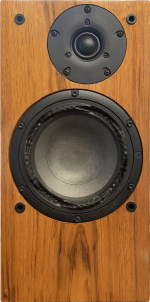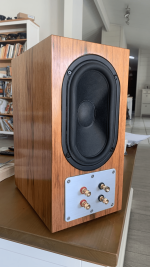Whilst fine tuning /calibrating the Brüel & Kjær measurement system, I thought I would share some measurements taken with the different processes with the software STEPS and REW.
These are taken with same drive level ~2.83V at speaker terminals, with a 44.1 KHz sample rate, of an un-marked 5.25” mid woofer in a ~1/4 cu ft enclosure, ported with a tuning frequency of 45Hz.
The microphone is 31.6cm from the baffle, on axis with the midwoofer. SPL id accurate to +/- 0.5 dB.
STEPS: 1/48 octave- time taken for test: ~12 mins
View attachment 1331859
STEPS: 1/24 oct- time taken for test: 6 mins
View attachment 1331860
REW Stepped sine, 24 points per octave.
default settings (64K FFT, Rectsngular window. 2 repeats) Time taken for test~18 mins
View attachment 1331861
REW (Farina log sine) Sweep, settings 256K samples x8 repetitions: time taken: 45 seconds:
View attachment 1331862
Some commentary is in order, I think, in order to aid interpretation of these graphs, for those unfamiliar with the software packages.
STEPS uses a stepped sine measurement process. The details of this process is beyond the scope of this post, however it is clear it provides the most detailed measurement. The disadvantage is the time taken to perform the test (minutes)
REW’s stepped sine function (accessible from RTA measurement Icon)it provides as much useful data as STEPS. So at least that’s consistent. But, is very slow. (If anyone can give me tips on how to speed it up- that would be much appreciated).
On the other hand, with REW’s standard Sweep function, by repeating the measuring 8 times to improve the signal to noise ratio (almost 10dB) over a standard single sweep measurement (not shown).
Furthermore, it smooths the fundamental with a 1/24th octave filter (fixed, non-deferrable) and shows harmonic curves that are much easier for our eyes/brain to interpret. Plus, it much faster.
Coming up- The Purifi midwoofer back under the attention of the Brüel & Kjær, as well as REW’s new FSAF (Fast subband adaptive filtering) measurement process (currently in beta testing) which measures harmonic and intermodulation distortion simultaneously, using noise signals or your choice of music clip/track
The only measurement of the four, where the hills are completely off, is the third:
"REW Stepped sine, 24 points per octave.
default settings (64K FFT, Rectsngular window. 2 repeats) Time taken for test~18 mins"
I missed this post
What is this?
You'll have to connect the dots for me Bernd- what am I looking at?
What is this?
You'll have to connect the dots for me Bernd- what am I looking at?
I'll post the pictures again for a better overview:
D2:

D3:

D4:

D5:

Fundamental:

[ screenshots taken from:
"REW (Farina log sine) Sweep, settings 256K samples x8 repetitions: time taken: 45 seconds"
in #66 ]
Now look for the same in the other 3 measurements
The only measurement of the four, where the hills are completely off, is the third:
"REW Stepped sine, 24 points per octave.
default settings (64K FFT, Rectsngular window. 2 repeats) Time taken for test~18 mins"
D2:
D3:
D4:
D5:
Fundamental:
[ screenshots taken from:
"REW (Farina log sine) Sweep, settings 256K samples x8 repetitions: time taken: 45 seconds"
in #66 ]
Now look for the same in the other 3 measurements
The only measurement of the four, where the hills are completely off, is the third:
"REW Stepped sine, 24 points per octave.
default settings (64K FFT, Rectsngular window. 2 repeats) Time taken for test~18 mins"
Last edited:
John Mulcahy, author of REW stated that, with a 10ms gate, [the appearance] "is more like applying a smoothing filter that is 100 Hz wide to a set of data with points every few tenths of a Hz."The REW log sweep (or rather exponentially swept sine as Farina named it) is surprisingly bad: the HF response is smoothed out and the noise floor high and rising...
yes correct. multiplication by a window 🪟 n the time domain equals convolution (ie filtering or smoothing )in the frequency domain.
in log frequency plot,we get a decreasing relative bandwidth as the frequency goes up and this is the opposite of what the graph shows
in log frequency plot,we get a decreasing relative bandwidth as the frequency goes up and this is the opposite of what the graph shows
I guess Klippel doesn't design crossovers?Wolfgang Klippel (and others) have found that THD isn’t a reliable predictor of sonic quality, yet the Klippel NFS show THD in red.
I am sorry, but there is otherwise NO WAY to know where on earth you want to cross tweeters, or other drivers.
Distortion measurements show A LOT more than just sonic quality.
Pick whatever color you like, fact is that B&W picture are just really hard to read.
Back in the day at my university you would get a big fat red cross through it all and you could do it all over again for exactly that reason.
It's also not very nice and respectful towards people with bad eye sight.
Continued....
Recall the frequency response measurement with various microphones in the near field?

Pretty close at +/- 1dB, except for the below the tuning frequency of the rear mounted passive radiator?
Recall the tested loopback performance of this amateur's setup, taking with REW using the (log sine) sweep?

Since it's own H2 is -90dB and H3 is -100dB...
It's capable of measuring any a speaker/microphone that is inserted into this loopback chain whose H2 is -70dB and H3 is -80dB or higher.
1 Driver Purifi PTT 6.5X04NFA in 1 cabinet- 14L cabinet with rear mounted 5x7" passive radiator


Using a drive level of 2.83V and mic distance of 10mm, we proceed to measure the distortion using REW's (log) sine sweep, with 44.1KHz sampling rate, 256K samples and 8 repetitions to reduce noise interference.
Here are 6 microphones for comparison:






I'll let you draw your own conclusions.
Recall the frequency response measurement with various microphones in the near field?
Pretty close at +/- 1dB, except for the below the tuning frequency of the rear mounted passive radiator?
Recall the tested loopback performance of this amateur's setup, taking with REW using the (log sine) sweep?
Since it's own H2 is -90dB and H3 is -100dB...
It's capable of measuring any a speaker/microphone that is inserted into this loopback chain whose H2 is -70dB and H3 is -80dB or higher.
1 Driver Purifi PTT 6.5X04NFA in 1 cabinet- 14L cabinet with rear mounted 5x7" passive radiator


Using a drive level of 2.83V and mic distance of 10mm, we proceed to measure the distortion using REW's (log) sine sweep, with 44.1KHz sampling rate, 256K samples and 8 repetitions to reduce noise interference.
Here are 6 microphones for comparison:
I'll let you draw your own conclusions.
Last edited:
So a lot of people have been showing results with false information because of a technicality?
Btw, speaking of REW, is there a way to get the calibrated sound pressure levels right?
When I try to calibrate my mics with my B&K calibrator, fill in the right values, REW doesn't do anything with it and/or messes up the values.
Btw, speaking of REW, is there a way to get the calibrated sound pressure levels right?
When I try to calibrate my mics with my B&K calibrator, fill in the right values, REW doesn't do anything with it and/or messes up the values.
@b_force
Illusions shattered
I will document my SPL calibration and Voltage calibration process in an update of the OP.
Illusions shattered
I will document my SPL calibration and Voltage calibration process in an update of the OP.
Well, it kinda puts the reliability of REW at stake.
For me personally REW already doesn't have good credits of so many quirky things and bugs
(one of them is calibration, but there are many other things)
Lack of any good documentation what's going on under the hood (like ARTA has) is also far from helping.
0.1% = -60dBr
0.03% ~= -70dBr (precisely 0.0316228%)
0.01% = -80dBr
If i were John Mulcahy i would put a 0.0316 label on the right side to the -70dBr line. -50dBr, -90dBr ... accordingly.
0.03% ~= -70dBr (precisely 0.0316228%)
0.01% = -80dBr
If i were John Mulcahy i would put a 0.0316 label on the right side to the -70dBr line. -50dBr, -90dBr ... accordingly.
AFTER:

Time for test: 45 seconds.
Recall: STEPS: time for test- 6 minutes

REW Stepped sine- time for test: 18 mins:

The software started as a tool for acoustical measurements of rooms (Room EQ Wizard), and now can do all kinds of things. I take the view that this software is actively being developed, with a very responsive developer, and it continues to improve with time. Users can try it for without, and if they use it and like it- donate!
I have friends in the software business. And they tell me, if we're going to release something that works perfectly, 100% of the time, with all the features that we wanted... well, it'd never be released.
So's Let's not complain, let's contribute!
PS.
Did you know the latest version can measure with real music?!

Time for test: 45 seconds.
Recall: STEPS: time for test- 6 minutes
REW Stepped sine- time for test: 18 mins:
The software started as a tool for acoustical measurements of rooms (Room EQ Wizard), and now can do all kinds of things. I take the view that this software is actively being developed, with a very responsive developer, and it continues to improve with time. Users can try it for without, and if they use it and like it- donate!
I have friends in the software business. And they tell me, if we're going to release something that works perfectly, 100% of the time, with all the features that we wanted... well, it'd never be released.
So's Let's not complain, let's contribute!
PS.
Did you know the latest version can measure with real music?!
Last edited:
Who is complaining? 🤔🤷♂️So's Let's not complain, let's contribute!
Providing feedback and critique, if presented positively and/or on a constructive way, is most definitely a good contribution.
Those are in fact fundamental building blocks to grow and get better.
Which is a wonderful positive thing indeed.
So I am confused why mentioning it?
Anyway, I assume that those measurement were done with a 44k1 sampling rate?
Would that also mean we can measure with (pink) noise?Did you know the latest version can measure with real music?!
Well, it kinda puts the reliability of REW at stake.
For me personally REW already doesn't have good credits of so many quirky things and bugs
(one of them is calibration, but there are many other things)
Lack of any good documentation what's going on under the hood (like ARTA has) is also far from helping.
Sure sounds like complaining to me. I fail to see the "feedback and critique, if presented positively and/or on a constructive way". I personally prefer the REW documentation over ARTA. I've also used a microphone calibrator with REW without any problems. Have you tried posting at the REW forum with your problems?
- Home
- Design & Build
- Equipment & Tools
- In search of low distortion omnidirectional microphones for DIYers